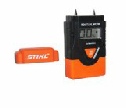
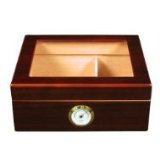
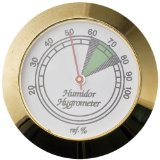
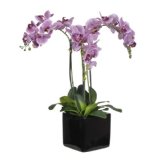
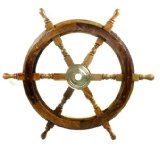
Moisture Meter Guide 2010 Contact details:garnett65@hotmail.com
Moisture Meter Guide
A very accurate instrument for determining the amount of moisture that is present in soil is the neutron moisture meter, or as it is sometimes known, the neutron probe. The neutron moisture meter works by emitting fast neutrons which are then reflected back slowly to a detector in proportion to the hydrogen atom concentration that is within the soil. The hydrogen atoms within the soil are predominantly found in water molecules. The neutron moisture meter will measure the detection of neutrons in a count rate relative to the count rate measured in water. The correct calibration allows the user to convert the count rate result to volumetric water content.
There are two main components to the neutron moisture meter; a probe and the gauge. The probe will contain a source of fast neutrons and the gauge will will monitor the flux of the slow neutrons which are scattered around by the soil which is being tested. To carry out a complete test it is necessary for the tester to have a cased hole in which to insert the probe. This probe is then inserted in to the soil with an access tube for the neutrons to be emitted. These emitted neutrons will then interact with any water that is present in the soil.
Neutron Moisture Meter
Where Do The Fast Neutrons Come From?
The fast neutrons are sourced by mixing alpha particles from a radioactive emitter with beryllium. Beryllium is a steel grey metal, with a crystal structure, that is brittle at room temperature. It is very stiff and has a high melting point.
With the nucleus of beryllium atoms there is a lossely held neutron and when this neutron is bombarded with alpha particles the result is the beryllium converting to carbon and a neutron of very high energy properties being released. These neutrons that are released have an average speed, you may not believe this, of a staggering 6000 miles per second. Hence the name fast neutrons.
How The Neutron Moisture Meter Works
The meter will emit fast neutrons in random directions in the soil. The fast neutrons will crash with any atoms that are in the soil. With continual crashing these fast neutrons will loose their energy and slow down to a speed of about 1.7 miles a second. When these neutrons are slowed down they have become thermalized and known as slow neutrons. It is only the slow neutrons that the neutron detector in the neutron moisture meter will count.
The basic principle of the neutron method of measuring moisture in soil is when a source is lowered in to the soil and fast neutrons are emitted. The soil causes the neutrons to slow down and scatter around. The probe of the neutron moisture meter then finds itself surrounded by slow neutrons. An equilibrium is reached with the soil absorbing the neutrons. With dry soil the neutron density will be less and spread further from the meter probe. With wet soil the neutron density will be more and spread not s far from the probe.
It is the density of the neutron cloud that the neutron moisture meter will measure and the results are sent as a signal to the meter which then displays a gauge reading of the moisture content in the soil.
Access Holes For The Moisture Meter Probe
When testing for soil moisture content with a neutron moisture meter it is necessary to have an access hole and tube for the probe to be lowered in to. The tubes require a snug fitting hole which can be drilled using a core auger. You should not put the tube in to a hole which is too big and then backfill the hole to make the tube snug fitting.
It is important to line the access hole with a durable tubing that will maintain the dimensions of the hole and not allow free water to move in to the hole. You want the access tube to be as small as possible, but big enough to allow free movement of the probe. The tube should have minimum thickness and be from a material that does not affect the movement of neutrons. Aluminium is the preferred choice.
When placing an access tube;
1 -
2 -
3 -
4 -
5 -
Calibration Of The Neutron Moisture Meter
When using a neutron moisture meter there are other factors besides the water in the soil that may affect the results. Elements such as cadium, iron, chlorine and boron absorb slow neutrons which will affect any results given. Within soil there are different forms of hydrogen from humus and organic plant matter which can also cause the moisture meter to give false readings. It is therefore necessary to account for these factores whenever testing soil.
Calibration curves for most soil types have been created and can be requested for a particular location. When properly used they are a vital tool to have when testing soil. The results from neutron moisture meters should be correlated to different types of soils. It must be remembered that a neutron moisture meter will give a reading for the total water content in soil. However not all of this water in the soil is actually available for plant use.
Safety With A Neutron Moisture Meter
Using a neutron moisture meter safely just requires a little common sense. One should always keep radiation exposure to a minimum and take good care of the meter and not damaging it. No matter how small the amount of a radioactive substance is, it is a potential health hazard. One must learn about and understand the hazards and the sensible handling of such a substance to avoid any potential dangers and personal injury.
To own a neutron moisture meter a special license is required and there are very strict rules about storage and transportation of one of these meters. Twice a year leakage tests must be carried out on the meter.
Moisture Meter Shop
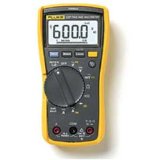

Wagner Moisture Meters
General Tools MMD5NP Pinless LCD
General Tools MMD7003 Precision
General Tools MMD8P Multi Species
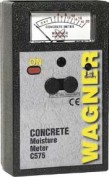
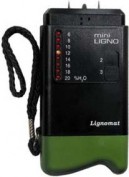


The Stihl moisture meter can be used to detect and give a moisture reading level in firewood. This is important if you have a log burning fire or stove. Stihl moisture tester
A moisture meter proves itself to be a useful tool when testing the moisture content levels of boat materials. When assessing a boat, care, judgement and experience should all be employed and then the moisture meter used as the last tool to give the final assessment. It is possible to give a good

Any caravan that is kept open to the elements all year round can become very susceptible to damp and damp related problems if proper precautions are not taken to prevent this.
Damp can invade your caravan through damaged seals, poor plumbing and inadequate cleaning. Without treatment you will find yourself having real problems as both mold and mildew can flourish in a damp caravan.
Firewood Moisture Meter
Boat Moisture Meter
Caravan Moisture Meter
Orchid Moisture Meter
The orchid belongs to a widespread and very diverse family of flowering plants which have fragrant and colourful blooms. Orchids can be found in pretty much every habitat. Orchid growing
The Complete moisture meter website
Veneer Moisture Meter
Veneer is very thin slices of wood usually thinner than 3 mm. They are usually glued Veneer moisture testing

Screed Moisture Meter
Screed is a type of concrete that is used to create a level surface on floor finishes, to encase any under floor piping or to be left as a hard wearing surface. Screed is laid on top of any existing concrete base. Screed moisture meters
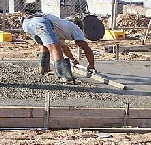
What Is Damp?
No matter the age of a house, it will contain moisture. The amount of moisture content will continually vary over a period of time. Damp moisture
Preservation Expert
If you have any damp or moisture issues and need advice then you should check out the preservation expert.
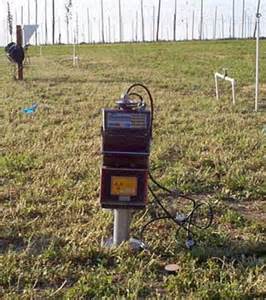
| Tramex Moisture Encounter Plus |
| Tramex Compact Wood Moisture Meter |
| Tramex Concrete Encounter Moisture Meter |
| Tramex Skipper Plus Moisture Meter |
| Tramex Roof And Wall Moisture Scanner |
| Sonin Digital Moisture Meter model 50218 |
| Sonin Digital Moisture Meter 270 model 50270 |
| Sonin Moisture Test Tool model 50210 |
| Sonin Moisture Test Meter Model 50211 |
| Oak |
| Douglas Fir |
| Beech Tree |
| Elm Tree |
| Hickory Tree |
| Maple Tree |
| Pine Tree |
| Prevent And Repair Gaps In Wooden Floorboards |
| How To Fix A Squeaky Hardwood Floor |
| How To Repair A Hardwood Floor That Has Buckled |
| Which Is The Best Firewood? |
| Concrete |
| Concrete Moisture |
| Screed Moisture Meter |
| SDS Drill |
| Belle Cement Mixer |
| SDS Drill Advice |
| Which SDS Drill |
| SDS Drill Accessories |
| Drilling Into Concrete |
| Kennedy Tool Box |
| Moisture - Basic Facts |
| Types Of Damp |
| Wet Rot |
| Dry Rot |
| Mold |
| Water Leak Detection |
| Stucco Moisture |
| Water Damage |
| Moisture And Rust |
| Moisture Damage To A Chimney |
| Wallpaper Stripper |
| Plaster Mixer |
| Why Worry About Moisture Problems |
| Does Your Home Have A Moisture Problem? |
| How To Solve Moisture Problems |
| How To Use Anti Mold Paint |
| Rising Damp |
| Condensation |
| Salt Damp |
| How To Avoid Bathroom Condensation |
| How To Remove Black Mold |
| How To Prevent Bathroom Mold |
| Soldering Kit |
| Soldering Kit Contents |
| Soldering Kit Advice |
| Bonsai Tree Classification |
| Growing Bonsai From Seed |
| Bonsai Tree Care |
| Bonsai Tree Training |
| Bonsai Tools |
| Displaying Bonsai |
| Bonsai Calendar |
| Bonsai Plants |
| The Thirsty Light Curve Moisture Meter |
| The Thirsty Light Ladybird Moisture Meter |
| The Thirsty Light Bumble Bee Moisture Meter |
| The Thirsty Light Butterfly Moisture Meter |
| Hanna Instruments |
| Agratronix Portable Coffee Moisture Tester |
| Lawn Aerator |
| Lawn Roller |
| Lawn Rake |
| Lawn Sand |
| Chainshot |
| Chainsaw Gloves |
| Chainsaw Trousers |
| Chainsaw Boots |
| Mac 4 - 20 XT Chainsaw |
| Mac 738 Chainsaw |
| Mac 842 Chainsaw |
| Mac 20X Power Chainsaw |
| Einhell BG-PC 3735 Chainsaw |
| Einhell BG-PC 4040 Chainsaw |
| Einhell BG-PC 5045 Chainsaw |
| Poulan P3314 Chainsaw |
| Poulan P4018 Chainsaw |
| Poulan Pro PP3816AV Chainsaw |
| Poulan Pro PP4218AVX Chainsaw |
| Poulan Pro PP4620AVX Chainsaw |
| Efco MT 4100 SP Chainsaw |
| Efco MT 3500 Chainsaw |
| Efco 132 S Chainsaw |
| Efco 147 Chainsaw |
| Efco 152 Chainsaw |
| Efco MT 7200 Chainsaw |
| Efco MT 8200 Chainsaw |
| Efco MT 3750 Chainsaw |
| Methods Of Obtaining Soil Moisture Levels |
| Hygrometer |
| Psychrometer |
| Rain Gauge |
| Wave Ventilation System |
| Humidity |
| Hygrometer For Keeping Reptiles |
| Humidor |
| Weather Stations |
| Musical Instrument Storage |